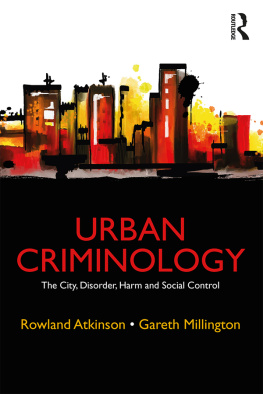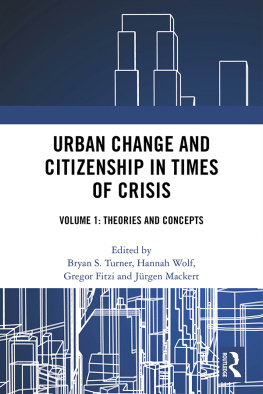The Invisible Minority
The Invisible Minority
Urban Appalachians
WILLIAM W. PHILLIBER
& CLYDE B. McCOY, Editors
with HARRY C. DILLINGHAM
Library of Congress Catalog Card Number: 79-4008
Copyright 1981 by The University Press of Kentucky
Scholarly publisher for the Commonwealth,
serving Berea College, Centre College of Kentucky,
Eastern Kentucky University, The Filson Club,
Georgetown College, Kentucky Historical Society,
Kentucky State University, Morehead State University,
Murray State University, Northern Kentucky University,
Transylvania University, University of Kentucky,
University of Louisville, and Western Kentucky University.
Editorial and Sales Offices: Lexington, Kentucky 40506
was written under the auspices
of the Appalachian Regional Commission
and is in the public domain.
ISBN: 978-0-8131-5395-7
Contents
Introduction / Urban Appalachians: Unknown and Unnoticed
WILLIAM W. PHILLIBER
1 / The Question of Appalachian Ethnicity
PHILLIP J. OBERMILLER
2 / Stereotypes of Appalachian Migrants
CLYDE B. McCOY & VIRGINIA McCOY WATKINS
3 / Appalachian Migration to Midwestern Cities
CLYDE B. McCOY & JAMES S. BROWN
4 / The Residential Distribution of Urban Appalachians
GARY L. FOWLER
5 / Population Changes and Trends in Appalachia
JEROME P. PICKARD
6 / Implications of Changes in Appalachia for Urban Areas
CLYDE B. McCOY, JAMES S. BROWN,
& VIRGINIA McCOY WATKINS
7 / Economic Costs and Returns of Appalachian Out-Migration
LARRY C. MORGAN
8 / Occupational Patterns of Appalachian Migrants
HARRY K. SCHWARZWELLER
9 / Occupational Adjustment of Appalachians in Cleveland
JOHN D. PHOTIADIS
10 / Accounting for the Occupational Placements of Appalachian Migrants
WILLIAM W. PHILLIBER
Conclusion / The Prospects for Urban Appalachians
MICHAEL E. MALONEY
Tables
Maps
Acknowledgments
Those whose names appear on the title page of a book or as authors of papers always owe a debt to many others who contributed to the final product. This book is perhaps even more heavily indebted than most because it is the result of a conference which involved the efforts of many. In particular we would like to acknowledge the contributions of Harry C. Dillingham, who chaired the Conference Planning Committee for the conference on Appalachians in Urban Areas and who first began to organize those papers in a form suitable for publication; Ralph R. Widner, director of the Academy for Contemporary Problems, who provided facilities and served as host to the conference; Virginia McCoy Watkins and Kathleen Sowders, of Cincinnatis Appalachian Committee (now the Urban Appalachian Council), who served as organizers of the conference; the Research Department of the Urban Appalachian Council, who assisted the editors in conference follow up; and Naomi Silverman, who typed the final manuscript.
Introduction WILLIAM W. PILLLLIBER
Urban Appalachians:
Unknown and Unnoticed
Since 1950 over three million people have migrated from the Appalachian region to the cities of the southern, eastern, and midwestern United States. In size, this migration compares to the total Irish immigration of 4.7 million or the Italian immigration of 5.0 million between 1820 and 1970 and is far larger than the Puerto Rican postwar migration of 1.0 million. Perhaps because it occurred entirely within the boundaries of the continental United States or because it involved people who already spoke the language and shared many of the national customs, it has remained a largely ignored aspect of changing America. What happened to the people who moved and to the areas where they located has not attracted the attention given other migrations.
The area that Ford (1967) called Appalachia and Campbell (1921) called the Southern Highlands was settled in the late eighteenth century principally by people of British and northern European heritage. The Blue Ridge Mountains separated them from the Eastern Seaboard while the Allegheny-Cumberland Plateau cut off areas to the west. These two ranges joined in the foothills of Alabama, forming a triangle which served to isolate the Appalachian people from the influences of the industrialized urban areas which developed around them. For many years they functioned in relatively closed systems, having little contact with outsiders (Ergood, 1976).
The ability of the area to support a large population declined over the years. The once large farms were subdivided by generations of inheritance into small tracts of worn-out land. The forests were harvested of their trees and left as rocky hillsides. Coal mines, which for a time involved large numbers of workers, increased automation and decreased total production, resulting in a substantial reduction in the number of employees. Appalachians turned to urban areas outside the region in an effort to provide for themselves. In the twenty-year span from 1950 through 1969, 3.3 million Appalachians migrated to other areas.
Much of the knowledge we have about Appalachian migrants in urban areas is based on the impressions of social workers and journalists. Their writings develop the thesis that Appalachians have migrated to ghettos where they are unable to adjust to urban life. Montgomerys (1968) description of Chicago, Hendersons (1966) story of Detroit, and Adamss (1971) portrayal of Cincinnati are examples of the type of work which has been done. In the absence of hard quantitative data, the writers have been forced to rely upon their own impressions or those of their informants.
Some noteworthy exceptions exist to the type of studies cited above. In Cincinnati, Schwarzweller, Brown, and Mangalam (1971) studied migrants from a community in Appalachia. They concluded that Appalachians do not experience serious problems of assimilation but take roles in urban areas which are of similar status to those they or their parents occupied before migrating. The ability to generalize these findings is limited both by the small number of people studied and by the reliance upon migrants from a single community. Maloney (1974) also included Appalachians in his analysis of the social areas of Cincinnati. He found that areas believed to be populated by Appalachians were the lowest in socioeconomic status and had the highest school dropout rates in the city. It is impossible, however, to disaggregate the data to determine if indeed it is the Appalachians in those areas who disproportionately experience poverty and withdraw from school. In fact, it is unclear how the reader can be sure the areas so identified are populated by Appalachians.
In Cleveland, Photiadis (1970) compared migrants from West Virginia to nonmigrants who remained behind and to migrants who returned home. He described the assimilation of migrants as a two-stage process in which West Virginians first moved to the ghettos of Cleveland, where they remained until they were able to move to better areas of the city. The result was an average level of economic attainment among migrants above that of people who remained in or returned to West Virginia. No comparisons were made between migrants and natives to the Cleveland area.







